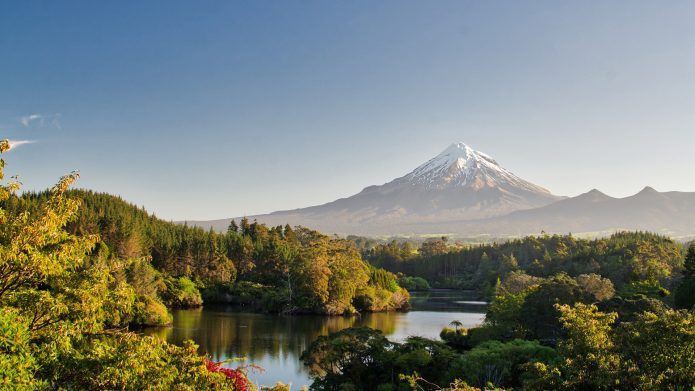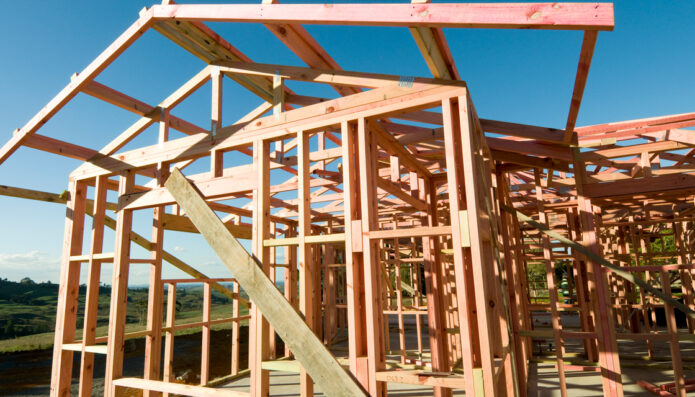PHOTO: OneRoof
According to ONEROOF The housing market has shifted down a gear, with the latest figures from the OneRoof-Valocity House Value Index showing an easing of house price growth across most regions.
Auckland property values have suffered their first drop in almost two years.
The city’s average property value fell 0.1% in the first three months of 2022 to $1.553 million, according to the OneRoof-Valocity House Value Index.
The drop was Auckland’s first quarter on quarter decline since first outbreak of Covid-19 put the country’s housing market on hold.
House prices in 58 of the city’s 276 suburbs dropped, with Mt Roskill’s average property value suffering a $166,000 drop, the country’s steepest.
The figures point to further house price tumbles in the city, with Auckland’s average value dropping 1.4% ($22,000) in March alone.
No other region saw price declines over the quarter or month on month, but the nationwide average property value did slip -0.27% to $1.098m in March.
James Wilson, head of valuations at OneRoof’s data partner, Valocity, said that home loan restrictions, rising inflation and the outbreak of the Omicron variant had dented Auckland house prices.
“Auckland is bearing the brunt of the housing market slowdown. The last time the city’s average property value dropped was June 2020, when the housing market was recalibrating itself after a two-month-long lockdown brought on by the arrival of Covid-19.
“However, back then interest rates were at an all-time low and buyer demand was rising. This time interest rates are on the up and the housing market is tipped for further declines.”
Northland recorded the biggest value rise over the quarter – 7.4% to $918,000 – but the March growth figure of 1.3% shows the heat has come out of the region’s housing market.
The slowdown was also evident in other strong performers: Taranaki’s average property value rose 6% over the quarter but grew just 0.56% in March, while Otago’s growth over the quarter was 5.5%, but 0.4% in March.
OneRoof editor Owen Vaughan said that the monthly growth figures pointed to more regions joining Auckland in negative territory. “The easing of Covid restrictions and the passing of Omicron peak will bring more positivity to the market as will the Government’s intention to defang the more contentious elements of the CCCFA, but the headwinds are building and market is clearly in slump territory.”
The monthly growth figures showed the housing market had cooled in New Zealand’s other major metros. Queenstown-Lakes’ average property value soared 9.6% over the quarter to $1.867m but only 0.86% of that was in March, while monthly growth slowed to 0.83% in Wellington and 0.25% in Christchurch after strong starts to the quarter.
Hamilton’s average property value dropped 0.32% in March, while values in Tauranga and Dunedin slid 0.16% and 0.13% respectively.
Four TAs – Auckland’s North Shore Waitakere, Westland and Lower Hutt – suffered drops in their average property value over the quarter and a further 24 dropped month on month.
The housing market was strongest in Wairoa, in Hawke’s Bay, where the average property value jumped 4.04% in March to $489,000, and Ruapehu, in Manawatu-Whanganui, which saw monthly value growth of 3.21% to $450,000.
However, most of the TAs that saw strong growth over the quarter cooled over the last month.
First home buyers’ share of purchases for the quarter nationwide dropped one point to 37.5%, while investors’ share of the market remained steady at 24%.
First home buyers were the dominant buyer group in every major metro except Queenstown, where investors claimed the lion’s share of the market, although their hold slipped over the summer, dropping from a high of 38% to 36.4%.
First home buyers increased their share of the market in Dunedin, from 42.9% to 44.6%. They also regained lost ground in Tauranga, climbing back from a low 33.6% to 35%.
The figures also pointed to resurgence in Hamilton investment market, with investors stepping into the void left by first home buyers, and lifting their share of new mortgage registrations from 30.1% to 33%.
Wayne Shum, head of research at Valocity, said the overall figures reflected the pressures buyers had felt since the introduction of tighter home loan rules in December.
“The relaxation of CCCFA announced in March may alleviate some of the difficulties first home buyers faced, but rising mortgage rates and cost of living pressures will continue to plague their purchasing decisions.
“Investors are also feeling the squeeze and some are reassessing the overall impact of rising interest costs and the inability to offset interest cost against rental income.”
Wilson said that whilst the economic headwinds facing the housing market were not strong enough yet to push values down across the board, the lack of confidence in the market was clear to see. “The quick step-change in the market has forced many buyers and sellers to adopt a ‘wait and see’ approach. For those who need to sell quickly, such conditions could result in pain or disappointment.”
Wilson added that while recent figures from the Real Estate Institute of New Zealand had shown monthly drops in Auckland’s median sale price, the OneRoof-Valocity House Index figures better reflected changes in the entire market.
“The median sale price is a reflection of what has sold over a certain period of time, and can be a good gauge of sale prices but is still limited by the number and price band of the stock that has sold. It may not always be the best indicator of the value of those homes that haven’t sold or aren’t on the market.”
“In times like this, when sales volumes are lower, more robust way to measure what’s happening in the market is to use value models, such as the OneRoof-Valocity House Value Index. This advanced model analyses all properties which have sold and compares them based on their characteristics and attributes to all homes in an area, so you are measuring how market trends/changes based on sales are impacting all homes in an area, not just measuring the changing nature of what’s sold.”
HOUSING MARKET AT A GLANCE
New Zealand’s average property value grew 21.5%, or $194,000, in the last 12 months to $1.098m, but dropped 0.27% month on month. Quarterly growth was 2.1%, or $23,000. Northland and Taranaki were the hottest regions over the quarter, recording value growth of 7.4% and 6% respectively. Wairoa, in Hawke’s Bay, was the country’s best-performing territorial local authority over the last three months, with its average property value up 18.7% to $489,000. Wairoa also registered the biggest value growth month on month – a jump of 4.04%.
Most expensive: Herne Bay, in Auckland, is still New Zealand’s most expensive metro suburb. Over the last three months it added another $107,000 to its average property value, reaching $4.225m. Its nearest metro competition is Saint Marys Bay, whose average property value hit $3.297m. Speargrass Flat, a lifestyle suburb north of Queenstown, has the highest overall average property value, at $5.142m (up 19.9%, or $854,000, on January’s figure on the back of some strong sales).
71 suburbs with 20 or more settled sales in the last 12 months have an average property value of $2m-plus, up from 59 three months ago and 31 a year ago. The $3m-plus club has also exploded; in April 2021 just four suburbs had an average property value of $3m and above, but none had broken the $4m barrier. Now, there are six suburbs in the $3m-$4m price bracket, one in the $4m-$5m bracket and one that’s broken the $5m barrier.
Cheapest: With an average property value of $238,000, Runanga, in Grey, is the best place to bag a bargain, but buyers should expect competition – the town saw value growth of 7.2% over the quarter and 40% over the last 12 months, a clear sign of rising demand. West Coast has seven suburbs with an average property value of less than $300,000.
In demand: Whiritoa, in Hauraki, recorded the biggest QoQ growth, with its average property value up 20% to $1.138m. Thirty-one suburbs saw their average property value grow by more than 10% in the last three months, down from 91 suburbs in the three months to the end of February.
Biggest winner: Speargrass Flat gained the most, dollar-wise, in the last 12 months. Its average property value jumped more than $1.4m. Year on year, 34 suburbs saw their average property value grow by more than $500,000.
Biggest loser: The suburb that has suffered the most over the last three months is Mount Roskill, in Auckland. Its average property value fell 11.6% ($166,000) to $1.268m. All up, 105 suburbs saw negative or zero growth in the three months to the end of March, up from 24 in the three months to the end of February. The majority of price declines were in Auckland.
* Figures only cover suburbs with 20-plus settled sales in the last 12 months.
————
Northland is the country’s strongest housing market, with the region’s average property value growing 7.4% ($63,000) in the three months to the end of March to $918,000. But the monthly growth figure of 1.32% indicates the region’s unusually hot summer run has come to an end.
The average property value in Kaipara, which is home to several high-value beach locations popular with Auckland buyers, exceeded the $1 million mark for the first time after quarterly growth of 9.4%. Value growth in Whangarei over the last three months was also high, at 8.3%, and brought the city $75,000 closer to joining Kaipara in the $1m club. Value growth in the Far North over the quarter was a solid 5.2%, but growth for the month was just 0.13%, which suggests the TA could be in negative growth territory come May.
————
Three of the region’s seven former local government areas – Auckland City, North Shore and Waitakere – recorded negative growth over the last three months, but all suffered drops in their average property value over the last month, a sign of further drops to come.
House prices in 58 of the city’s 276 suburbs dropped over the quarter, with Mt Roskill suffering the biggest decline. Its average property value fell 11.6% ($166,000) to $1.268m. Other problem suburbs include: Torbay (down 6.4%, or $97,000, to $1.409m); Te Atatu Peninsula (down 4.8%, or $69,000, to $1.371m); Henderson (down 4.6%, $55,000, to $1.132m); and Avondale (down 4.3%, $57,000, to $1.17m).
The city’s most expensive suburbs haven’t escaped the downturn either, despite claiming some big sales over the quarter. Prices slid 1.4% ($44,000) in Remuera and 1.2% ($27,000) in Waiheke Island’s Palm Beach.
————
Waikato’s average property value inched its way closer to $1m, with the region recording QoQ value growth of 3.5%, but monthly growth was a barely noticeable 0.2%.
At a TA level, prices slipped in Hamilton (-0.32% over March) and Waikato (-0.8%) but the brakes were on across the region, with Hauraki’s QoQ growth of 12% crumbling to just 0.98% in the last month.
Of the 105 Waikato suburbs that recorded 20 or more settled sales in the last year, six saw no growth or negative growth over the last 12 months. Pokeno, just south of Auckland, suffered the biggest decline, with its average property value down 6.3% ($72,000) over the last three months to just above $1m. Also on the slide were Meremere (-2.6%), Raglan (-1.4%), Te Kauwhata (-1.1%) and Port Waikato (-0.6%). Cambridge is also at risk, having recorded no value growth over the quarter.
Forty Waikato suburbs saw value growth of more than 5% over the quarter. The high-end beach town of Whiritoa saw a 20% jump in its average property value, from $941,000 to $1.138m, on the back of some big sales in January and February.
————
House prices in the Bay of Plenty have continued to ease: growth was 3.9% in the three months to the end of March, down from 4.4% in the three months to the end of February and 5.7% in the three months to the end of January. Monthly growth was 0.65%, with the region’s average property value sitting at $1.077m.
The region has largely avoided the value declines seen in Auckland, thanks to solid growth in the Western Bay of Plenty, which has benefited from strong holiday home sales, and a levelling off of price declines in Rotorua.
Of the 66 Bay of Plenty suburbs or towns that registered 20 or more settled sales in the last 12 months, 10 saw no growth or negative growth over the last three months. Most were in fringe or rural locations, with the biggest price declines in Mamaku, in Rotorua (-5.1%); Waiotahe, in Opotiki (-2.7%); and Fordlands, also in Rotorua (-1.8%). High-end Pyes Pa, in Tauranga, also felt the slowdown, with its average property value falling 1.3% ($16,000) to $1.225m.
READ MORE VIA ONE ROOF
MOST POPULAR
 Simon Bridges’ Tauranga family home passed in at auction | WATCH
Simon Bridges’ Tauranga family home passed in at auction | WATCH Abandoned land for sale
Abandoned land for sale NZ winery billionaire whose private jet brought the body of Shane Warne back from Thailand
NZ winery billionaire whose private jet brought the body of Shane Warne back from Thailand ‘Unacceptable’: top real estate agents axed
‘Unacceptable’: top real estate agents axed Rebel Wilson lists her stunning Sydney Harbour mansion
Rebel Wilson lists her stunning Sydney Harbour mansion Kiwi home owners face soaring mortgage repayments as rates jump
Kiwi home owners face soaring mortgage repayments as rates jump Kiwis leaving New Zealand in droves – 20,000 to leave this year
Kiwis leaving New Zealand in droves – 20,000 to leave this year HOUSING CRISIS: 80 percent of property investors are planning rent rises
HOUSING CRISIS: 80 percent of property investors are planning rent rises Taupō’s Hole-in-One Challenge revamp | WATCH
Taupō’s Hole-in-One Challenge revamp | WATCH Sexy real estate agents – FUN Instagram Page | sexy.agents
Sexy real estate agents – FUN Instagram Page | sexy.agents


















